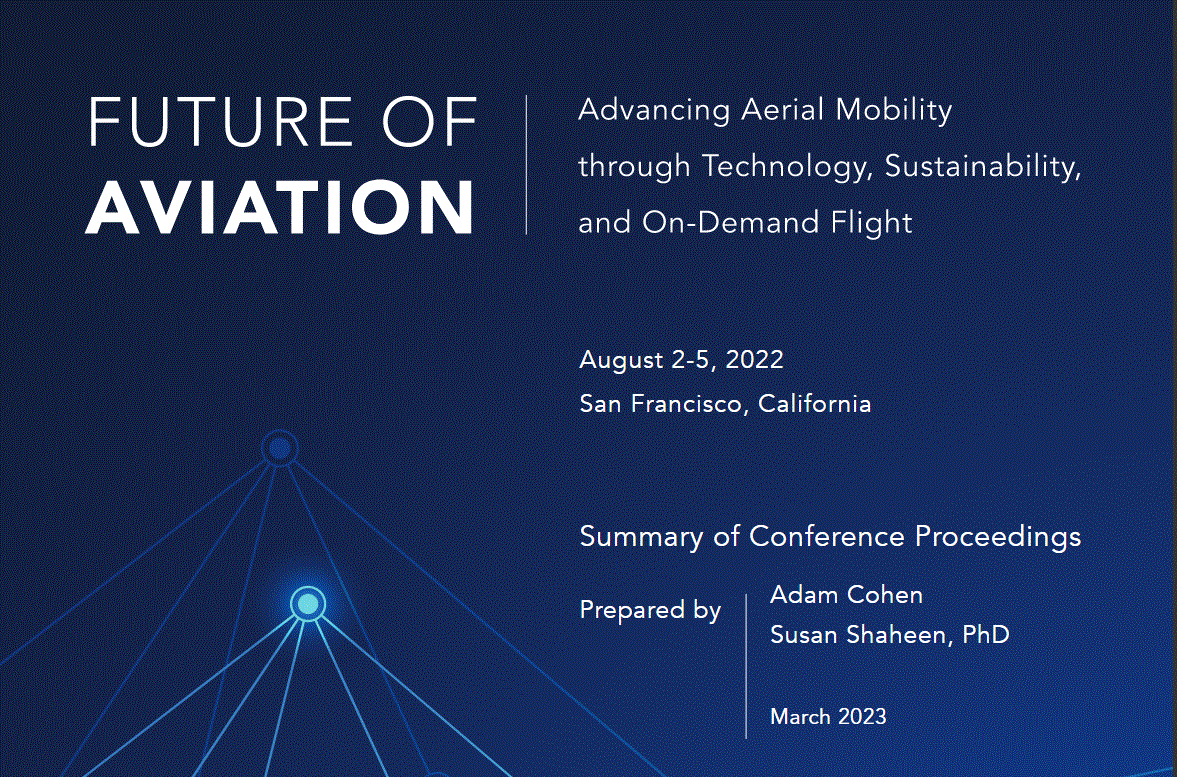
Adam Cohen and Susan Shaheen PhD have published the proceedings of The Future of Aviation Conference: Advancing Aerial Mobility through Technology, Sustainability, and On-Demand Flight, hosted by the University of California, Berkeley,and held in person at the San Francisco International Airport from August 2 to 5, 2022. The conference commenced with an AAM 101 workshop hosted by the Community Air Mobility Initiative (CAMI) on August 2nd.
The event advanced key research and policy discussions around environmental impacts, safety, security, equity, multimodal integration, and the role of government.
Key insights and discussion points from the workshop include the following:
- AAM must be anchored in the public good. The conference highlighted the importance of prioritizing humanitarian, aeromedical, and emergency response use cases to demonstrate broad societal benefit and build public acceptance of emerging AAM technologies.
- Safety is existentially critical because many of the AAM use cases envision operations in low altitude airspace over urban areas. A single crash could lead to widespread AAM disapproval. A number of safety issues that will still need to be addressed include: 1) airworthiness, operations, electric propulsion, pilot standards, and low-altitude air traffic control; 2) interaction between humans, machines, and highly complex software; and 3) maintenance training, among others.
- A systems and multimodal approach are needed. Technology often innovates faster than the regulatory environmentcan be updated. A number of speakers emphasized the importance of an aviation systems planning and multimodal integration approach that deeply integrates AAM with existing transportation services (both ground and air).
- Need to look at alternative fuels more holistically. Numerous electrification challenges were identified, such as grid capacity, aircraft range, aircraft down-time due to charging, lifecycle impacts, and battery recycling, among others. Numerous speakers emphasized the importance of examining alternative fuels to help address these challenges and enable larger aircraft and longer-distance operations (e.g., regional air mobility).
- Opportunities for new collar jobs. AAM has the potential to support a variety of direct, indirect, and ancillary jobs to enable the emerging aviation ecosystem. Workforce development and training programs are needed to support new collar jobs,mostly technical occupations that require specialized skills in the areas of operations and operational support, engineering,vehicle design and manufacturing, business and financial operations, quality control and safety, medical and travel services,and hospitality.
- Public acceptance is not the same as community engagement. There is a difference between engaging communities and building public support for AAM. Speakers emphasized the importance of evolving community engagement from informing and consulting the public to collaboration and community empowerment where the public can influence decision-making and outcomes.
- Different stakeholders have different definitions of equity. There is not a single definition of ‘equitable AAM.’ For pilots, air carriers, and OEMs, equitable AAM can be viewed through the lens of equitable airspace access. For the public and community partners, equity is often viewed through the lens of public involvement and outcomes (e.g., who bears the benefits and impacts of AAM implementation).
- Equity process (engagement) and outcomes are both important. Both meaningful involvement in the AAM decision-making process and equitable protection from environmental and other impacts are key. Numerous speakers discussed the importance of integrating environmental justice principles (i.e., the fair treatment and meaningful involvement of all people)into AAM planning, decision-making, and implementation.
- All levels of government must work together. The planning and implementation of AAM will require a multi-governmental approach that includes federal, state, and local governments to implement safe, sustainable, and equitable outcomes.

